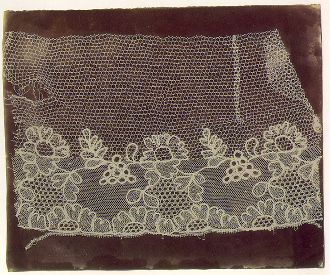|
© Copyright 2003 by the
Photography Criticism CyberArchive. All rights reserved. photocriticism.com |
 |
This printout is for reference only.
Reproduction and distribution of multiple copies prohibited. |
Archive texts:
History of Photography
The Pencil of Nature (1844-46)
Part V (cont.): PLATE XX. LACE
AS this is the first example of a negative image that has been introduced into this work, it may be necessary to explain, in a few words, what is meant by that expression, and wherein the difference consists.
The ordinary effect of light upon white sensitive paper is to blacken it. If therefore any object, as a leaf for instance, be laid upon the paper, this, by intercepting the action of the light, preserves the whiteness of the paper beneath it, and accordingly when it is removed there appears the form or shadow of the leaf marked out in white upon the blackened paper; and since shadows are usually dark, and this is the reverse, it is called in the language of photography a negative image.
This is exemplified by the lace depicted in this plate; each copy of it being an original or negative image: that is to say, directly taken from the lace itself. Now, if instead of copying the lace we were to copy one of these negative images of it, the result would be a positive image of the lace: that is to say, the lace would be represented black upon a white ground. But in this secondary or positive image the representation of the small delicate threads which compose the lace would not be quite so sharp and distinct, owing to its not being taken directly from the original. In taking views of buildings, statues, portraits, &c. it is necessary to obtain a positive image, because the negative images of such objects are hardly intelligible, substituting light for share, and vice versâ.
But in copying such things as lace or leaves of plants, a negative image is perfectly allowable, black lace being as familiar to the eye as white lace, and the object being only to exhibit the pattern with accuracy.
In the commencement of the photographic art, it was a matter of great difficulty to obtain good positive images, because the original or negative pictures, when exposed to the sunshine, speedily grew opaque in their interior, and consequently would not yield any positive copies, or only a very few of them. But, happily, this difficulty has been long since surmounted, and the negative or original pictures now always remain transparent during the process of copying them.

For citation purposes, the specific online source for this text is: